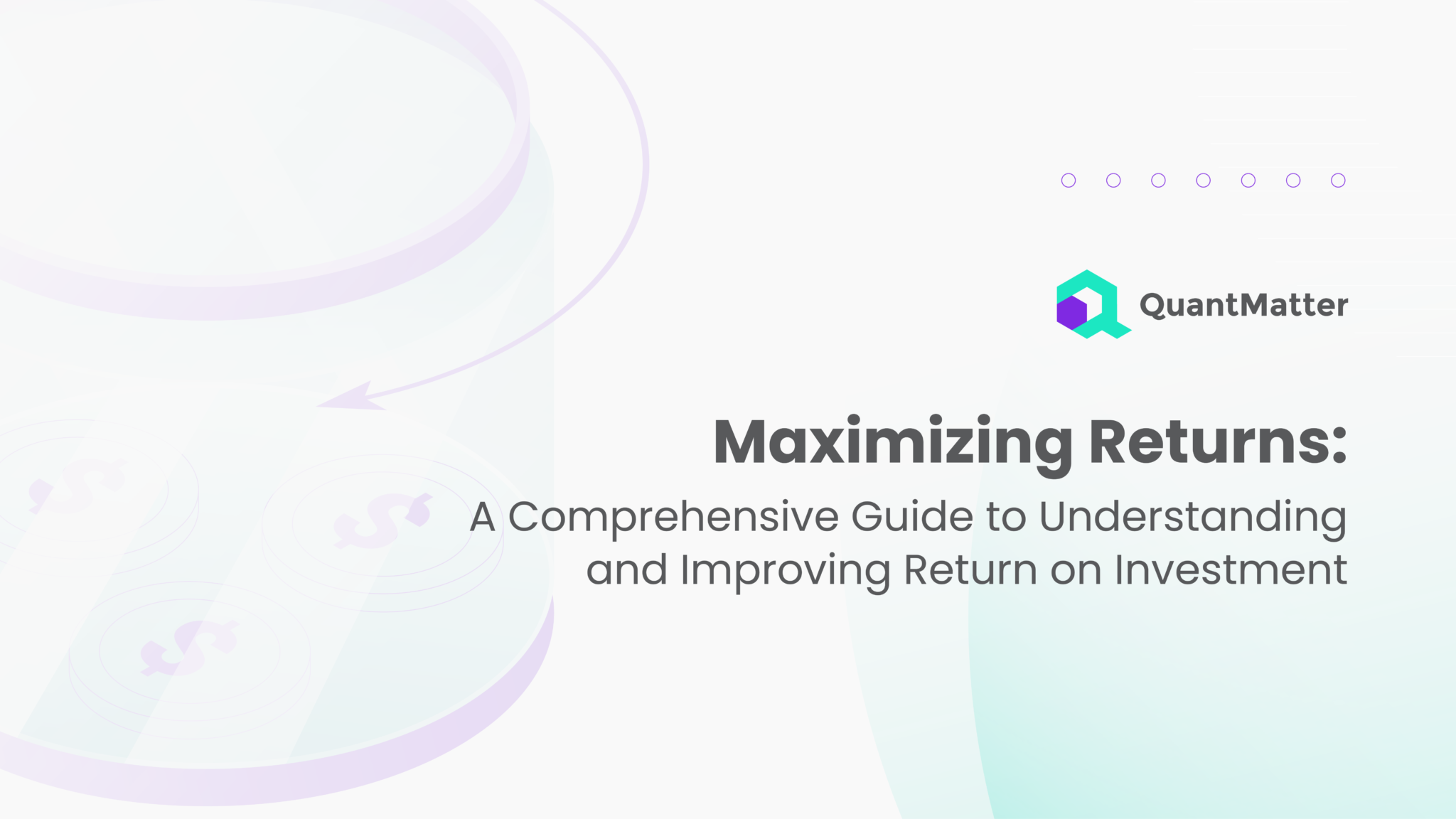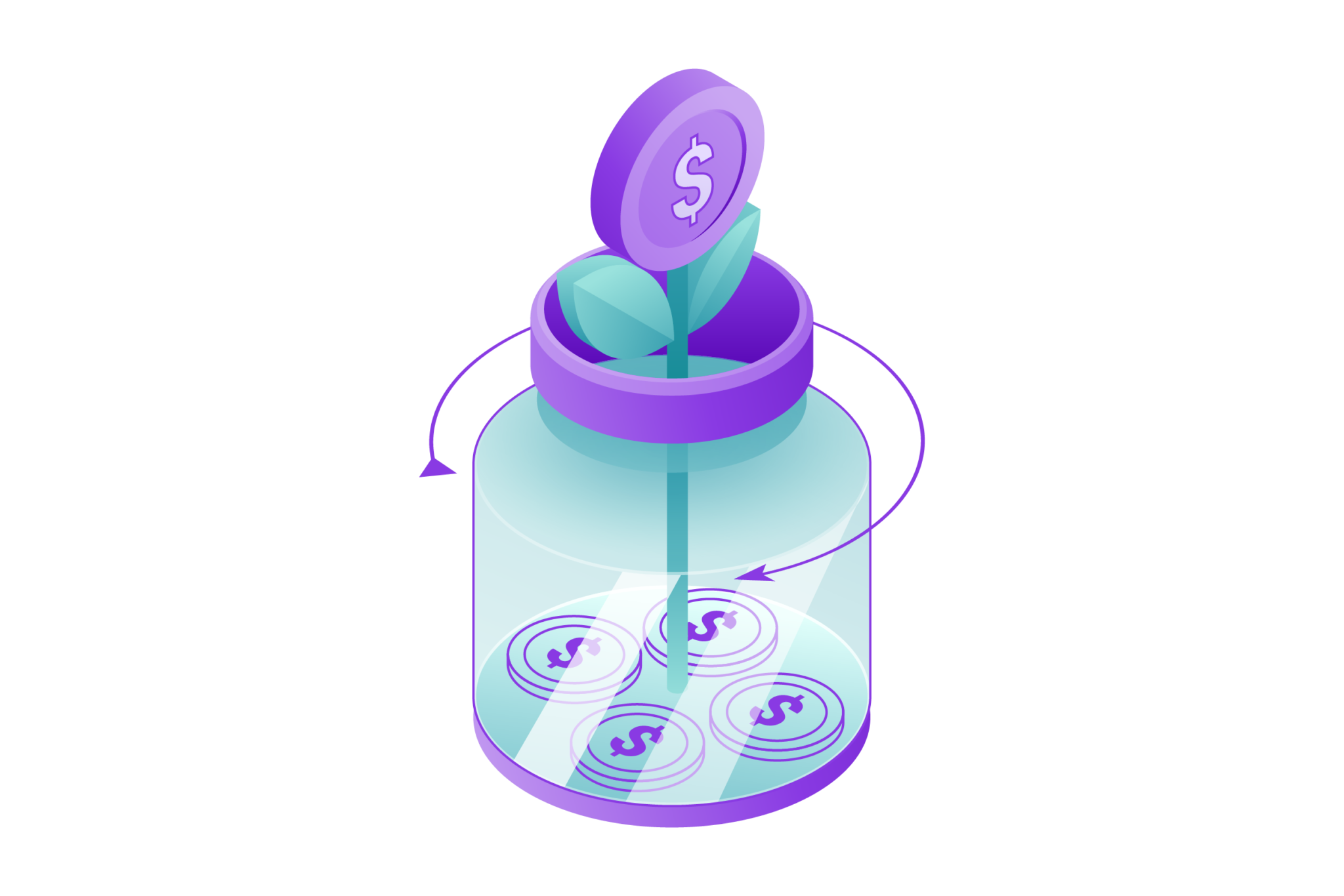
ROI is an important metric in the corporate world that indicates investment profitability and efficiency. Aligning your investments with your financial goals is like a compass, guiding you on the right course that you need to make effective decisions. This means that every investment decision should be made with a clear goal in mind and should fit into the larger scheme of your financial future.
This alignment promotes strategic planning and helps to achieve better ROI in the long run. You should understand what ROI is and how to maximize it, whether you’re an experienced investor, a business owner, or just someone trying to make smart money choices. In this article, we’ll talk about return on investment (ROI) and how we can improve it. We’ll also look at some practical tips for making smart investment decisions.
Understanding ROI

ROI is a strong financial indicator that is easy to understand and can accurately determine the profitability of an investment. This metric provides a simple method to evaluate the potential investment return by removing the complexity of finances while analyzing it.
“The formula for ROI is elegantly straightforward:
(Net Gain / Initial Cost) x 100 “
Above is the formula for ROI. So, it tells you how much you made or lost on that investment. This percentage is very important because it shows whether a certain business venture is successful or not.
A profitable outcome is achieved when the net gain exceeds the initial investment. This means a positive ROI. This outcome is what all the investors aim for because it demonstrates that the money has not been invested in vain. In contrast, a negative ROI is a clear indication that the investment isn’t generating the anticipated returns, hence leading to a financial loss.
Most people who invest money or analyze financial things use return on investment, or ROI for short, to determine whether something is worth investing in or not because it is easy to understand compared to different investment options.
ROI is an extremely important measurement that enables us to evaluate the profitability of an investment. The simplicity of the metric is what makes it very valuable for investors who have to deal with a lot of complex information. It represents the entire situation in a single percentage, which makes it easy to understand.
Factors Influencing ROI

There are various things that affect return on investment (ROI), and it makes decisions about money investment very complex. It is very important for investors to understand these factors in order to make wise decisions and achieve higher returns on their investments.
– Investment Strategy and Objectives
Investment strategy is a vital thing for an investor to have because it lays the groundwork for their investment decisions and eventually determines their success. There are different ways of doing things, and each has its own advantages and disadvantages. Well value investing is an investment strategy where we look for assets that are undervalued and expect that over time people will realize this and the asset’s value will increase, so we can make a positive return on investment (ROI).
In contrast, growth investing involves investing in businesses with high growth possibilities. This approach typically involves accepting higher risks to achieve greater returns. This means that income investing is focused on getting a continuous flow of income either through dividends or through interest payments. The emphasis here is on getting a stable income rather than on getting a quick increase in the value of the investment.
Well, the objectives and time horizon of the investors play a significant role in calculating their ROI. The choice of strategy depends on the time horizon of the investor. Long-term investors prefer slow but steady growth, whereas short-term traders look for quick gains. It is important to match your investment plan with your objectives and risk tolerance in order to improve the return on investment (ROI). This is unique to each person.
It is important for investors to remain adaptable and adjust their investing techniques as the markets change. This will enable them to stay ahead of the game and maximize their profits. Adopting a dynamic approach to investment strategy enables us to take advantage of burgeoning opportunities and overcome obstacles, in turn improving the ROI of our portfolios.
– Market Conditions
Market conditions have a big effect on the ROI, which is because of the general economic environment in which the investments happen and operate. Dynamic economic factors such as trends, interest rates, and market volatility can greatly affect returns. When the economy is growing, the returns on investment may be higher because people are spending more money and companies are making more profits. On the flip side, when the economy goes down, companies face problems and people spend less, so the ROI is less.
Interest rates are important because they will have an impact on ROI, especially when it comes to borrowing money. Low interest rates are beneficial to businesses because they reduce borrowing costs, which can increase their profits. In contrast, an increase in interest rates can result in an increase in the cost of borrowing money, which subsequently affects the returns on investment for leveraged investments. Fluctuations in financial markets are introducing both opportunities and risks. This is market volatility. During volatile periods, investors may have higher returns, but at the same time, the risk of bigger losses is also there. It’s important to understand and adapt to market conditions in order to make good investment decisions and have a better ROI.
Also Read: Market Making: Strategies and Techniques
– Risk Tolerance
The level of risk tolerance that an investor has plays an extremely important role in their investment decisions and subsequently determines their potential gain. It shows how much an individual is willing to accept losses in their investment portfolio. If you are willing to tolerate a higher level of risk, then you may consider investing more in stocks, mutual funds or emerging markets in hopes of higher returns. But remember, with higher risk comes a greater possibility of loss. On the other hand, risk-averse investors might lean towards more stable, lower-yielding assets such as bonds or blue-chip stocks.
It’s important to be able to understand how much you’re willing to take a chance on your investments in order to make your investment choices match your personal desires and financial objectives. It is important to take into account the time frame in which you are willing to invest, the goals that you want to achieve, and your own personal tolerance for market movements when making investment decisions. By being aware of their own risk tolerance, investors can make better choices that align with their specific needs, resulting in time-saving and more efficient portfolio management.
What is more, risk tolerance is not fixed and may go through changes because of differences in financial conditions, market events, and personal experiences. It is essential to periodically reevaluate one’s risk tolerance levels so that the investment strategy remains consistent with the evolving financial circumstances, which would lead to improved investment opportunity optimization.
– Diversification
The strategy of diversification plays a vital role in decreasing the risk and increasing the ROI. By diversifying your portfolio, you reduce the risk of losing a significant amount of money if one investment performs badly. Diversification is a complex approach that aims to gain the advantages of different investments while putting limits on the losses that could result from investing everything in a single asset.
By including a variety of things, like shares in companies, bonds, property and other kinds of investments, in a portfolio, you can get a more comprehensive view of the markets and reduce the chances of losing all your money if one specific type of investment performs poorly. The approach is used to reduce the risk of investment, as different investments may affect the market differently. Diversifying your portfolio doesn’t completely eliminate risk, but it definitely makes your investment portfolio riskier. This strategy could potentially help you enjoy more consistent returns in the long run.
Students should take into account not only the type of properties in their investment portfolio but also the relationship between them. Well, in my opinion, it would be better if we invested in assets that have a low correlation with each other because it would help us manage the risk more effectively. It’s important to keep an eye on market conditions and adjust the diversification strategy accordingly to achieve higher returns and minimize risk.
3 Effective Strategies for Maximizing ROI

Students use a variety of methods to solve various problems in mathematics, with the ultimate goal of maximizing their grades. Can someone explain how these strategies contribute to achieving financial success?
1. Active Portfolio Management
The task of maintaining an active portfolio requires regular checks and modifications to its investments in order to achieve maximum returns. Portfolio managers or individual investors make purchases and sales of assets depending on the market climate, overall trends, and remarkable investment opportunities. This technique involves being updated with the current market trend and adapting quickly according to changes in circumstances. By actively creating a portfolio, investors aim to capitalize on short-term market inefficiencies and trends, potentially enhancing overall ROI.
One strategy that is used to keep track of your portfolio is active management, which includes changing the allocation of assets as per the present market conditions. But on the other hand, during periods of economic downturn, an active manager might increase exposure to bonds, expecting lower returns but less volatility. On the other hand, when the economy is uncertain, they tend to move towards defensive assets to protect their capital. Active portfolio management requires constant attention to detail and consistent monitoring. If done correctly, it can yield better results than passive portfolio methods, especially in fast-moving markets.
2. Leverage and Margin Trading
Using borrowed money to expand the size of an investment aims to amplify the incentive for achievement. Margin trading is a common practice where investors can borrow money to buy more stocks or securities. While leverage can increase the ROI when the investment is profitable, it also amplifies the losses when the market turns against us. Those investors using leverage need to know if they can handle the risk and what the outcomes will be.
Leverage can either be great or bad; it depends on the situation and what you are trying to achieve. Marginal calls are a tool used by brokers to manage risk. When an investor fails to meet the requirements for a marginal call, the broker can force the investor to liquidate their positions. To ensure a successful use of leverage, it is essential to be disciplined, manage risks carefully, and have in-depth knowledge about the investments being leveraged. This strategy is ideal for experts in the investment industry possessing the necessary experience to manage amplified market exposure better.
3. Value Investing
Value investing is like buying stocks that are undervalued. It’s kind of like what Benjamin Graham and Warren Buffett did. It means finding those companies that are being overlooked by the market and buying them when they are trading for less than what they are really worth. This involves a complete examination of the financial statements, examining the qualities of the organization, and examining the prevailing industry trends to recognize unknown chances that may have been missed by other investors.
In value investing, it is important to have a long view, wait patiently for the market to turn in your favor and be mindful of the fundamentals of the stocks or other assets you are investing in. Value investing does not always provide instant returns, but it has a long term strategy that believes that the market will ultimately recognize real value in investment and thus may gain substantial returns. A value investing strategy is aimed at identifying market inefficiencies and trading on them by getting securities that are undervalued or trading at a discount of their intrinsic value and achieving a better risk return profile.
ROI Long-Term vs. Short-Term Investments

When it comes to investing, you have to decide whether to go long-term or short-term. This decision is really important, and it impacts the returns you will get. In this research, we investigate how to calculate the ROI for both long term and short term investments. By grasping the attributes, merits and drawbacks of every strategy, investors can generate intellectual judgments that are suited to their individual financial aims.
– Long-Term Investments
When we talk about long-term investments, it means that we’re putting our money into things that we plan on keeping for a really long time, like maybe even more than ten years! The primary goal of long-term investing is to grow richer in the long run by increasing the value of assets and multiplying the returns over time. Long-term investments can include various options, such as stock, bonds, real estate and retirement accounts.
Long term investment has the potential for compound growth. When investment returns generate more returns over time, it’s called compounding. By using the power of compounding, the initial investment can grow really big if you keep reinvesting the gains. Students who take a long-term perspective on the market tend to be better equipped to handle the volatility that comes with short term fluctuations. Since historically, markets have gone up over time. Moreover, long-term investments have tax benefits, such as reduced capital gains tax rates for assets held for over one year.
Investing with a long-term perspective requires a lot of patience and a strict way of following a plan. Yeah, it’s very important for investors to do their homework, don’t put all their eggs in one basket, and keep track of their investments frequently to make sure they’re achieving their objectives.
Also Read: Market Maker Options: Definition and How They Make Money
– Short-Term Investments
Short-term investments are when you invest for a short time, like less than a year, and the goal is to make quick profits from it. Some of the usual small-term investments that we take are money market fund instruments, CDs and short term bonds. The main aim of temporary investment is to maintain the capital value and earn small returns within a brief period of time.
Short-term investments are usually less risky than long-term investments, making them a better option for people with a low tolerance for risks or those who need their funds soon. However, the downside of having lower volatility is that the potential returns are also lower. Short term investors, including me, can take advantage of quick changes in the market and make profits rapidly.
Though short-term investments have several benefits, they also have their drawbacks. For one, taxes can eat into any gains made, and inflation can reduce the ROI over time. When it comes to investing, you have to pay attention to timing. It’s not just about having a long-term strategy; you also need to monitor the market conditions in real-time.
– Comparative Considerations
It is important to carefully consider financial goals, risk tolerance, and time horizon when deciding between long-term and short-term investments. Such investments are appropriate for achieving long-term objectives like planning for retirement, building wealth and saving for significant life occasions. Investing in stocks is like playing a game of roulette; the rewards can be huge, but the risks are also immense.
However, short-term investments are better suited for goals with a more specific timeline, such as buying a house or funding a large purchase. Short-term investments might not offer the same growth opportunities as long-term investments. A good investment plan is one that has a balance between long-term investments and short-term ones. Investing in different kinds of assets and time-frames can reduce chances of losing money and also make it possible to fulfill different financial objectives in the future.
Conclusion
Unlocking the benefits of this journey is not a one-time activity but rather a continuous process involving ongoing evaluation, constant monitoring and smart decision making. The way to maximize profit from investment is by using effective strategies. In order to achieve long-term success in investing, you need to focus on several key areas. These include diversification, keeping a close eye on your investments, reducing costs, and making sure your investments align with your financial goals. By implementing these strategies in your investment approach, not only can you minimize risks, but you also open doors for growth and achievement.
Diversification is an important way to increase the rate of return. Diversifying my investments is crucial, as it will decrease the risk of having a badly performing investment adversely affect the overall performance of my portfolio. By implementing this approach, investors can balance their portfolio and increase its sustainability.
Disclaimer: The information provided by Quant Matter in this article is intended for general informational purposes and does not reflect the company’s opinion. It is not intended as investment advice or a recommendation. Readers are strongly advised to conduct their own thorough research and consult with a qualified financial advisor before making any financial decisions.

I craft stories that make complex ideas clear. I simplify the blend of data science, machine learning, and crypto trading, showcasing how advanced tech and quantitative models analyze data for informed trading choices. Join me in exploring the realm of quantitative trading, where my narratives make intricate concepts easy to grasp.
- Alifia Berizkyhttps://quantmatter.com/author/alifia-berizky/
- Alifia Berizkyhttps://quantmatter.com/author/alifia-berizky/
- Alifia Berizkyhttps://quantmatter.com/author/alifia-berizky/
- Alifia Berizkyhttps://quantmatter.com/author/alifia-berizky/
